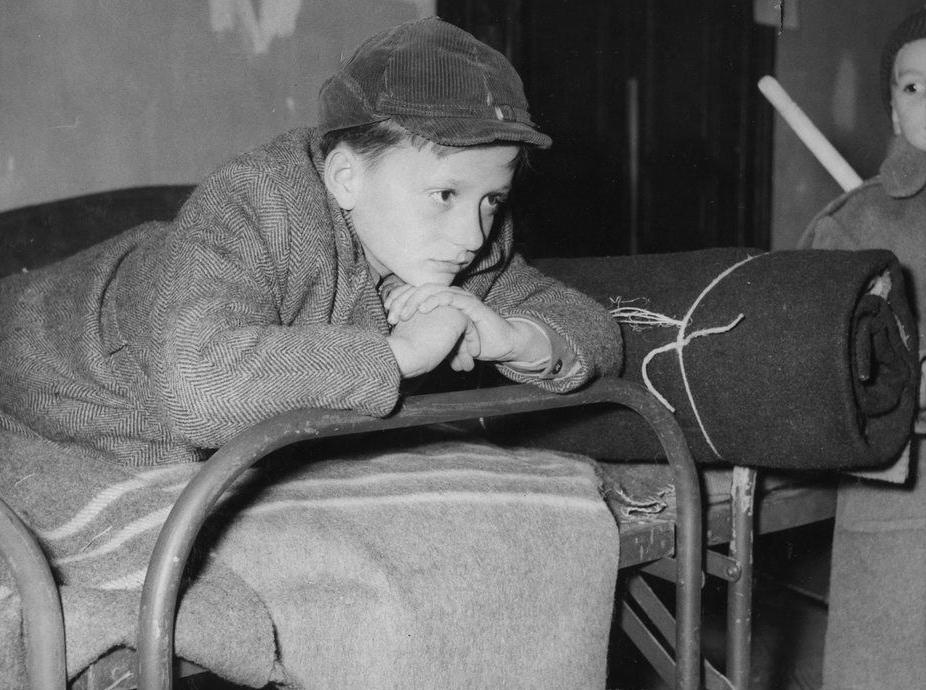
The Hungarian Revolution Refugees: Humnitarian Effort Institutions--International Committee for the Red Cross

Figure 1.--Among the refugees wre unaccimpanied minors, mostly bous. They had ge=rown up under Cimmunism abd received nothing, but Communist propaganda in the schools, Young Pioneers, and Party-controoled media. Yet they chose to fight for freedom. This boy has reached what he assumed was safety in Austria. The press caption read, "This little Hungarian boy looks reflectively - into the past or tge futur? He is one of the many thousands who had fled from Hungary to Austria. This picture was taken at Traiskirchen in a forner army barracks just outside Vienna." The photograph is dated November 9, 1956. Unknown to him was that Soviet authoritie and the regime Red Army tanks installed in Budapest were demanding that the Austrians and ICRC return him and other unaccompanied minors to Hungary, aginst their will if necessary. The ICRC and Western humanitarian authoritis did not always do right about these boy, but it didn't return them to the Comminists.
Image no: DMN 9067/2.
|
|
The UNHCR oversaw intense multilateral talks in Vienna. The agency with very limited resources and staff decided to delegate many of it most important tasks to the Internation Committee of the Red Cross. The ICRC had a number of core competencies and not only had well-estabished member organizations, not only in Austria and Yugoslavia where the refugees were arriving, but in the Soviet Union and Hungary as well. Of course the Hungarian and Soviet Red Cross was under Soviet control which meant that after the Soviet intervention, they were not about to aid refugees attempting to flee Soviet control or to dispassionately deal with individuals who decided to return to Hungary. It did not begin that way. A Swiss author described the ICRC's effort in Hungary with several primary source documents on the ICRC's activities in Hungary during the crisis. [Cardia] With the outbreak of the Revolution, the ICRC began transporting and distributing western aid in Hungary, working with the democratically elected new leadership of the Hungarian Red Cross. This changed with the Soviet intervention. There was extensive damage because of the fighting. There was also a general strike paralizing activity. This was aimed at the Soviets, but also impaired relief activities. Hungary as a result, desperately needed relief supplies. Thus even the Soviet installed Kádár government renewed copperation with the ICRC (mid-November). The agreement signed at that time ran through June 1957. The initial promising start working with the Hungarian Red Cross soon developed major impediments once the Soviets were back in control. The Soviet installed Kadar government wanted and nbeeded the aid, but Kadar demanded total control over distribution. And Kadar rejected all efforts on the part of the ICRC Swiss staff to provide legal protection and humanitarian assistance to the thousands of Hungarian civilians interned or imprisoned by the Soviets. Another issue which developed was two principles which conflected -- family reunification and the child (minor) refugees that desired asylum in the West. Kádár representative demanded that the ICRC should provide them a list of all the Hungarian refugees in western host countries. And Kadar represenatives insisted that the ICRC actively participate in returning all unaccompaied child (mostly teenafers) refugees as quickly as possible. Here the ICRC showed real backbone. The ICRC Swiss staff agreed with the dominant western point of view, understanding how refuge lists could be used by the KGN and HUngarian security agencies to puish family members still in Hungary and thus pressure if not terrorize the refugees. We now know just how brutlly many of the anti-Communists weretreated. The ICRC steadfastly insisted that political refugees were entitled to anonymity and a free choice in deciding where they wished to live--including the unaccompanied minors. This position infuraured the Soviets and Kadar representatives who could not or would not believe that neferious Western capitalist influences were not a work. Other were quite aware of what they were doing abd simply wanted to punish those who opposed Soviet or Communist control. This included both devout Communists and othees who understood that the Soviets were in control and that it was dangerous to resist raw Soviet power.
Sources
Cardia, Isabelle Vončche. L'octobre hongrois entre croix rouge et drapeau rouge (Brussels: Bruylant, 1996). The English edutiin is Hungarian October: Between Red Cross and Red Flag: The 1956 Action of the International Committee of the Red Cross (Geneva, 1999).
CIH

Navigate the Children in History Website:
[Return to Main Hungarian Refugee page]
[Return to Main Hungarian Revolution page]
[Return to Main Hungarian Cold war page]
[Return to Main Cold War country page]
[Return to Main Eastern European revolts page]
[Return to Main Communism page]
[Introduction]
[Animals]
[Biographies]
[Chronology]
[Climatology]
[Clothing]
[Disease and Health]
[Economics]
[Geography]
[History]
[Human Nature]
[Law]
[Nationalism]
[Presidents]
[Religion]
[Royalty]
[Science]
[Social Class]
[Bibliographies]
[Contributions]
[FAQs]
[Glossaries]
[Images]
[Links]
[Registration]
[Tools]
[Children in History Home]
Created: 1:01 PM 4/10/2015
Last updated: 1:01 PM 4/10/2015



